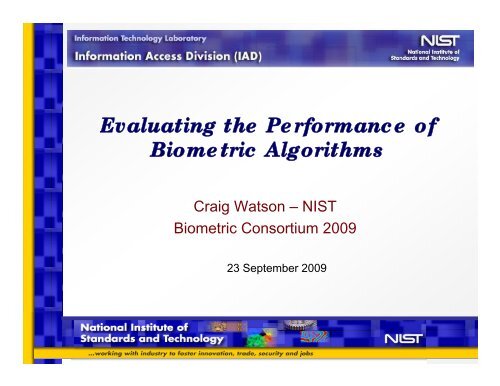Evaluating the Performance of Biometric Matching Algorithms
Evaluating the Performance of Biometric Matching Algorithms Evaluating the Performance of Biometric Matching Algorithms
Evaluating the Performance ofBiometric AlgorithmsCraig Watson – NISTBiometric Consortium 200923 September 20091
- Page 2 and 3: Outline• Why NIST?• Impact and
- Page 4 and 5: Impact of Evaluations• Current me
- Page 6 and 7: Evaluation ProcessDevelop API/Prepa
- Page 8 and 9: Evaluation Process• Software Vali
- Page 10 and 11: Sequestered DatasetsUsed for Evalua
- Page 12 and 13: Large Scale Evaluations• SAN Stor
- Page 14 and 15: Large Scale Evaluations• Use larg
<strong>Evaluating</strong> <strong>the</strong> <strong>Performance</strong> <strong>of</strong><strong>Biometric</strong> <strong>Algorithms</strong>Craig Watson – NIST<strong>Biometric</strong> Consortium 200923 September 20091
Outline• Why NIST?• Impact and Issues with Evaluations• NIST Evaluation Process• Datasets• NIST Evaluations• Future Plans
Why NIST Performs <strong>Biometric</strong> Evaluations• Mandates:• Patriot t Act (PL 107-56)• Enhanced Border Security and VISA Entry Reform Act (PL107-173)• Homeland Security Presidential Directive 12 (HSPD-12)• 10-Print Transition: mandated by Homeland SecurityCouncil Deputies Committee• Develop testing methods for evaluating biometricsperformance• Advance biometric i matching technologies• O<strong>the</strong>r Government Agencies
Impact <strong>of</strong> Evaluations• Current measure <strong>of</strong> biometric technology performanceon operational data.• Algorithm developers can evaluate performance withoperational datasets.• Advance biometric matching technologies.• Improve implementation’s adherence to standards andprotocols
Issues with Performing Evaluations• Baseline algorithms (bozorth) give ability to developevaluation methods• Developing API to meet evaluation needs• Dataset sample size• Dataset preparation and security• Repeatable results• Validation/Security <strong>of</strong> submitted SDK• Interpretation <strong>of</strong> results
Evaluation ProcessDevelop API/Prepare DatasetApplicationResultsS<strong>of</strong>twareError CheckTest DriverReportValidationEvaluate
Evaluation Process• API• Inputs/Outputs to interface with SDK• Consider “gaming” issues• Use existing standards when possible• Length <strong>of</strong> time to run evaluation• Dataset Preparation• Consolidations• Sample selection – random, sample size, diversity <strong>of</strong>data• “True” imposter data• Data format• Length <strong>of</strong> time to run evaluation
Evaluation Process• S<strong>of</strong>tware Validation• Repeatable – why not?• Resolve issues <strong>of</strong> non compliance• Estimate length <strong>of</strong> time to run evaluation• Evaluation• Managing across multiple systems – enrollment andmatching stages• Unexpected exits• System maintenance shutdowns• Length <strong>of</strong> time to run evaluation• Confidence in results• What to report• Statistical significance• Error check “outliers”
Public DatasetsAlgorithm Development & SDK Validationbiometrics.nist.gov/databases• Fingerprint• NIST Special Databases – 4, 9, 10, 14, 24,29, 30• Face• NIST Special Database 18• ColorFERET• Iris • Iris• ICE dataset
Sequestered DatasetsUsed for Evaluations• Fingerprint , Face, and Iris• Operational Datasets from sponsoringagency• Large number <strong>of</strong> subjects (100,000 –6,000,000)• Multiple Instances• Meta-data for results analysis
<strong>Biometric</strong>s Evaluations at NISTbiometrics.nist.gov/evaluationsFace RecognitionVendor Technology(frvt@nist.gov)Slap FingerprintSegmentation(slapseg@nist.gov)Minutiae Exchange(minex@nist.gov)Face RecognitionVendor Technology(frvt2006@nist.gov)<strong>Biometric</strong> UsabilityIris Challenge(ice@nist.gov)Ii Iris Exchange(irex@nist.gov)20 00320 00520 00720 00920 00220 00420 0062008FingerPrint VendorTechnology (fpvte@nist.gov)Proprietary FingerprintTemplates (pft@nist.gov)Ongoing MINEX(minex@nist.gov)Face RecognitionGrand Challenge(frgc@nist.gov)Iris ChallengeEvaluation(ice@nist.gov)Latent FingerprintTechnology (ELFT)(latent@nist.gov)t@ t MINEX II(Match on Card,minexII@nist.gov)Multiple <strong>Biometric</strong>Grand Challenge(mbgc@nist.gov)SlapSegII(slapseg@nist.gov)ELFT-ExtendedFeature Sets(latent-efs@nist.gov)Multiple <strong>Biometric</strong>Evaluation(mbe2009@nist.gov)11
Large Scale Evaluations• SAN Storage for large datasets (240TB)• High end computing• 32 blades (4x4) with 192GB memory• 24 blades (2x4) with 48GB memory• 80 blades (2x2) with 16GB memory• 136 blades -> 336 CPU -> 1024 cores
Evaluation <strong>of</strong> Latent FingerprintTechnologies-Extended Feature Set(ELFT-EFS)• Gallery feature space 8-12GB• Current: 80 blades (2x2) 4GB memory, 70 GBlocal storage workspace• Upgraded: 16GB memory to allow searchingbackgrounds 10K subjects with 10 rolled printsor slaps each.• 300GB local storage workspace• OS upgrades to 64-bit Linux and windows.
Large Scale Evaluations• Use larger sample sizes in existing 1-to-1 evaluations(PFT, MINEX, …)• Large scale biometric identification evaluations (1-to-many)• Government needs for evaluations on large datasets• Testing methods and APIs for large-scale evaluations
Thank YouCraig Watsoncraig.watson@nist.govbiometrics.nist.gov/evaluations15



